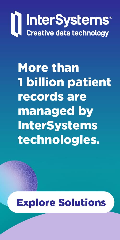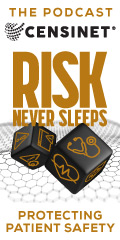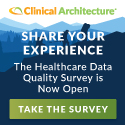HIStalk Interviews Roger Davis, CEO, T-System
Roger Davis is president and CEO of T-System of Dallas, TX.

Tell me about yourself and the company.
I’ve worked for over 30 years in healthcare in variable roles, including being on the provider side in academic, not-for-profit, and for-profit medicine. I’ve held a number of leadership roles companies including Accenture, GE Healthcare, Perot Systems, and Dell Computer, among others. I’ve spent a lot of time in healthcare in a lot roles on the provider side, the vendor side, and the consulting side.
With regard to T-System, I’m very proud to be here. Our marketing people gave me a note indicating that we’ll have our twentieth birthday in June of this year, which is remarkable for a company like ours. We have domain expertise in emergency medicine and a longevity that exceeds anybody else in our market. I’m very proud to be here in this great organization.
What are the biggest issues in the practice of emergency medicine in hospitals?
Maybe just a slight correction in that regard. We certainly have a large component of our practice that supports hospital-based emergency departments, but it’s important to know that we are also a very strong market presence in the freestanding emergency department space, as well as in the urgent care space. We have a very broad application across that unscheduled care environment and significant footprints in each one of those.
Having said that, there probably is a common set of challenges within that organization set, things that they share and challenges they face together. Perhaps the most important is the obligation to more actively deliver on outcomes in those healthcare spaces. Those clinical events are largely unscheduled and the outcomes can be challenging because they’re not quite sure what’s going to walk in the door at any given time. They have a unique clinical environment to deliver within. Associated with that are the challenges that the technology supporting it has to meet.
Our business, our mission is to support that clinical delivery in that unique environment. You enhance those challenges with the things that everybody else in healthcare sees, like ICD-10, regulatory requirements, and additional burdens with regard to capacity for providers. All of those are challenges. All of those are issues which we bring a technology solution to in that urgent care ED space.
What impact have your customers seen from the passage of the Affordable Care Act?
Because of the evolution of this space, sometimes the metrics are a little bit challenged depending on who you’re talking to. What we think we see in the footprint in the folks that we serve is that the overall count of hospital-based emergency departments is probably slightly declining. Having said that, while there are fewer hospital-based emergency departments, the capacity or the volume of patients they’re seeing is increasing, based on the fact that there is an increasing funded base of patients now.
They’re seeing more patients in fewer environments on the hospital-based ED side. That compression of capacity we think is forcing, or at least accelerating, these alternate care sites. They include freestanding emergency departments and urgent care centers. A lot of increase both in number and capacity in those two care settings, based in part on the pressures of the hospital-based EDs with regard to capacity.
How are the needs of freestanding EDs and urgent care centers different from those of the hospital ED?
This is one of those classic answers … if you’ve seen one, you’ve seen one. There are certainly some commonalities with regard to freestanding EDs and urgent care centers. There are multiple business models and some are unique.
Having said that, the freestanding emergency departments, as I’m sure most of your readers know, are fully functional emergency environments, where they are able to deliver radiology and laboratory and complex care for life-threatening clinical scenarios.
Urgent care centers more typically are a high-access, high-availability, more primary care sort of environment. They are characterized by the ability of a patient to simply walk in and receive care when they choose to and where they choose to. Urgent care centers may be the best manifestation of the scenario of converting to retail medicine that people have described historically. Urgent care centers really are that model. Freestanding EDs are a version of that model that is more focused on acute medicine and higher degrees, or higher orders, of severity.
Your customers have a greater need than anyone to be able to quickly see a patient’s medical records from wherever they’ve been treated. Has their access to that information improved in the past few years as people focus more on interoperability?
You’ve touched on one of the things that we spend most of our time thinking about, and certainly more recently with some of the announcements from CMS and the discussions at HIMSS — this notion of interoperability and its importance. The availability to access patient records historically is very important, certainly in our care setting as well as others.
Maybe even more importantly, though, when we talk about interoperability from a T-System perspective, we’re more interested in what that looks like as a next version. In terms of real-time capabilities of moving data between applications in order to optimize both the provider’s capability as well as the patient outcomes, we’re really thinking more about the velocity of data movement as it supports true clinical interoperability at the care setting and for providers and patients.
T-System joined CommonWell last year. What are you seeing as either the current or future benefit?
We think CommonWell, together with some other organizations, represents a forward-looking view of what the relationship between application vendors should be in support of clinical care.
In that context, I will say that early in the year, Andy Slavitt spoke at the JP Morgan Healthcare Conference. He delivered a very important viewpoint from our perspective. That speech on January 11, together with the follow-on paper they produced called “The Future of EHR,” sets the tone for organizations like CommonWell and how we think about how organizations should be interactive.
He was very specific in terms of a requirement for “leveling the technology playing field.” He talked about a requirement for vendors to interchange data. He used the term "deadly serious" when he referenced interoperability and data exchange. He talked about referencing open APIs as a specific model for integrating data and moving it seamlessly between technologies.
Our hope and expectation is that much of what Andy talked about in that view is reflected in organizations like CommonWell and in the behavior of our vendor peers in the healthcare space.
Has your business been affected as health systems move from best-of-breed systems to a single-vendor approach?
In any business vertical, there are cycles between enterprise and specialty solutions, whether that’s in finance or ERP or other. Most business verticals see this transition over time between enterprise solutions and specialty solutions.
You could take a view that Meaningful Use at some level drove more enterprise-type behavior, as there was incentive simply to adopt a platform. Our growth was relatively level over that period of time. We were still meaningful and remained meaningful through that period.
If you go back to what we talked about with interoperability and you think about a next cycle in that enterprise to specialty model, where organizations are looking for next levels of performance and higher tiers of technology capability, that’s where organizations like ours are primed to participate and meaningfully contribute.
We see that, on a go-forward basis given the levels of interoperability we’re talking about, the decisions that are going to be made going forward are much more around outcomes and provider enablement as opposed to the fact that it’s nice to have a single platform.
How have you addressed your audience’s need for usability?
This clinical environment, this emergency environment, has to be the most challenging and demanding of providers. The technology that they utilize similarly has to behave in a way that is probably disproportionately capable to a traditional EHR because of the pressures and demands associated with that emergency environment.
T-System, from a solution perspective, has over the last 20 years defined its value relative to that requirement. The notion of complex care delivery in a high-pressure setting is exactly what T-System was formed on 20 years ago and the value that we continue to enhance today. That includes not only the notion of a per-click model, but much more importantly, we spend an inordinate amount of effort and time and talent to refine the user interface of our products, such that they make sense clinically, but they deliver clinical value and that they support physician thinking, nurse thinking, and management of workflow within the ED. That optimizes that environment and supports the complex sorts of outcomes that they have to deliver.
What are the ED opportunities to deliver better outcomes at a lower cost?
At its core, beginning 20 years ago, T-System solutions were developed on clinical templates which carried embedded clinical intellectual property. All of the learning that we have developed and aggregated from an emergency perspective is collected and combined within the views that we present to clinicians. That clinical learning directly translates to optimizing clinical outcomes because it is an aggregated clinical IP set. We deliver those over each one of our clinical views. That substantially advances clinical outcomes.
Where do you see the company going in the next five years?
You used the term best-of-breed. We love that term. We love being best. Being best means enhancing those things that differentiate us and enhancing those things that provide value differently from a more traditional EHR vendor.
We see ourselves moving in that space in a couple of different ways. First, back to Andy Slavitt’s comment, we began in 2015 to make a significant development commitment towards open API models and developing both Web delivery and open API capabilities. We have doubled down in that space given where we think the market is moving. We think our ability to interoperate and to be a leader in participating in that model is substantial and significant for us in an area where we’re focused on a go-forward basis.
The second thing we’ll do is continue to enhance our clinical content, continue to aggregate our domain expertise and awareness, such that we will enhance outcomes as CMS and others have indicated as a priority.
The third thing is, again beginning last year, we understood that because of the complexities of EHR environments and because of the different requirements in each of those clinical settings, we could better serve our clients by looking at a modular delivery capability as opposed to one solution, take it or leave it. In the context of developing more actively in a Web-delivered, API-enabled solution, we’re moving more toward modularizing capabilities within our solution set that we could interoperate and deliver more flexibly than we do today. A significant direction for us going forward in that five-year horizon is that modular capability with aggressive interoperability.
Do you have any final thoughts?
Your questions have touched on nearly every single value message we like delivering. From a personal perspective, I can’t imagine being at a better place with a better organization. The legacy here in the ED space is remarkable. I was at HIMSS talking with someone I had never met before who was an ED physician. As soon as I introduced myself and the company I was from, she couldn’t speak highly enough about T-System and her experience with our products and how it had enabled her clinically. For the almost two years I’ve been here, that scenario is played out over and over again. It makes me very grateful to be here.
We feel positively about how our company is positioned. Our opportunity in this new season of interoperability is to be extremely meaningful across a variety of care settings, interoperating with anyone from a legacy EHR, enterprise EHR perspective. We’re excited about that. We’re glad we are where we are.



















































































Is this HIStalk or Reddit? Hard to tell the difference with the comments being posted.